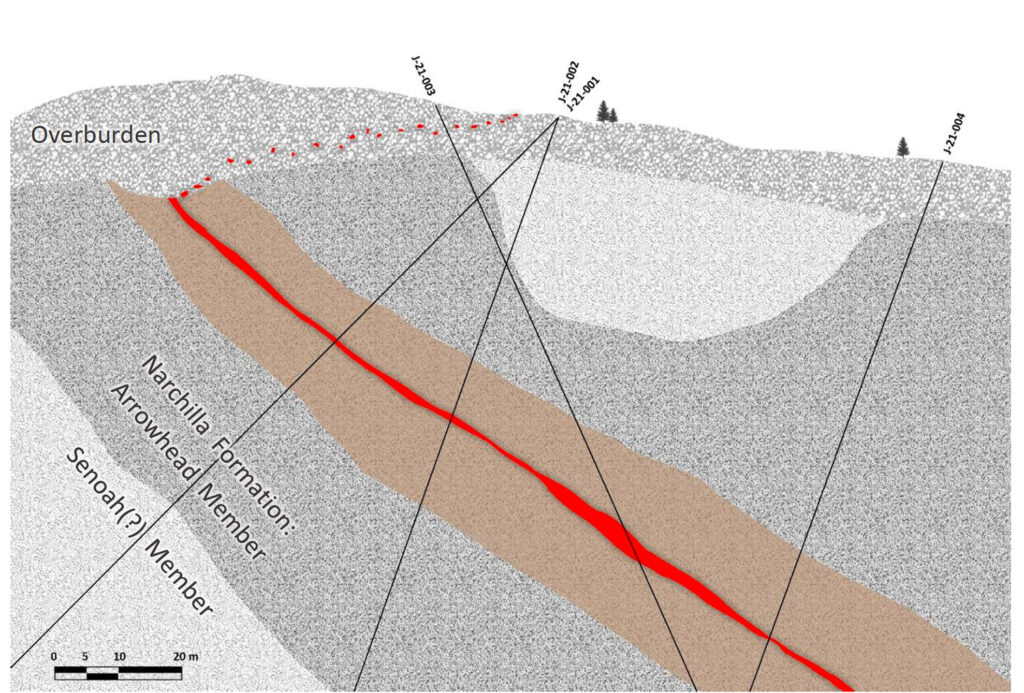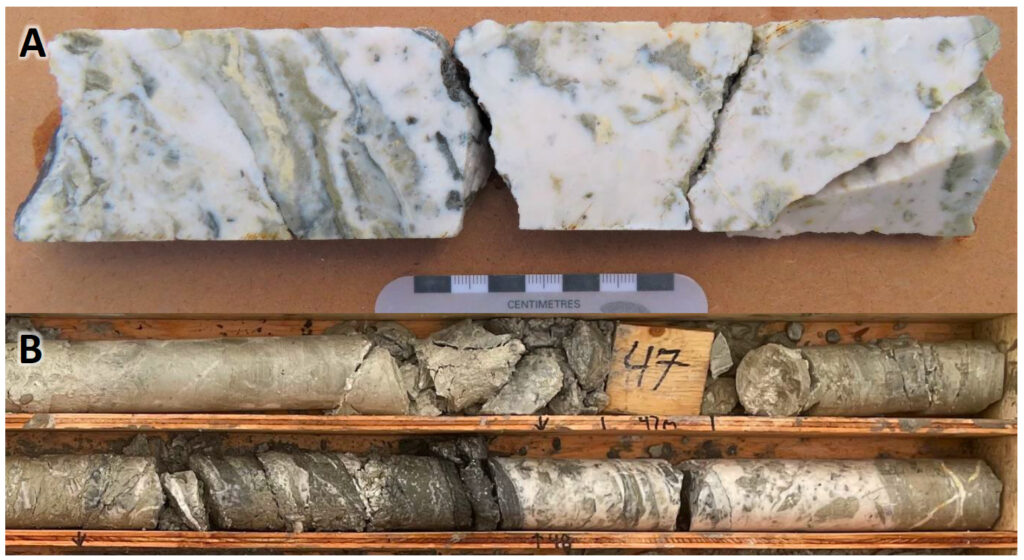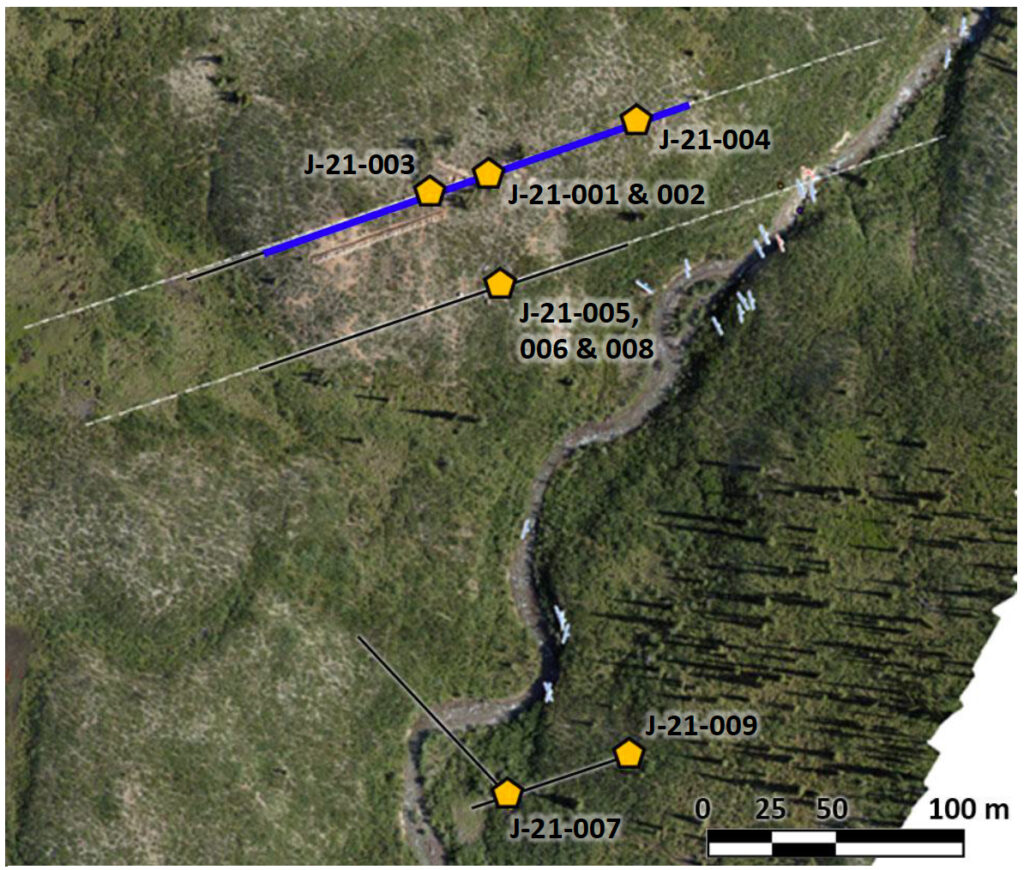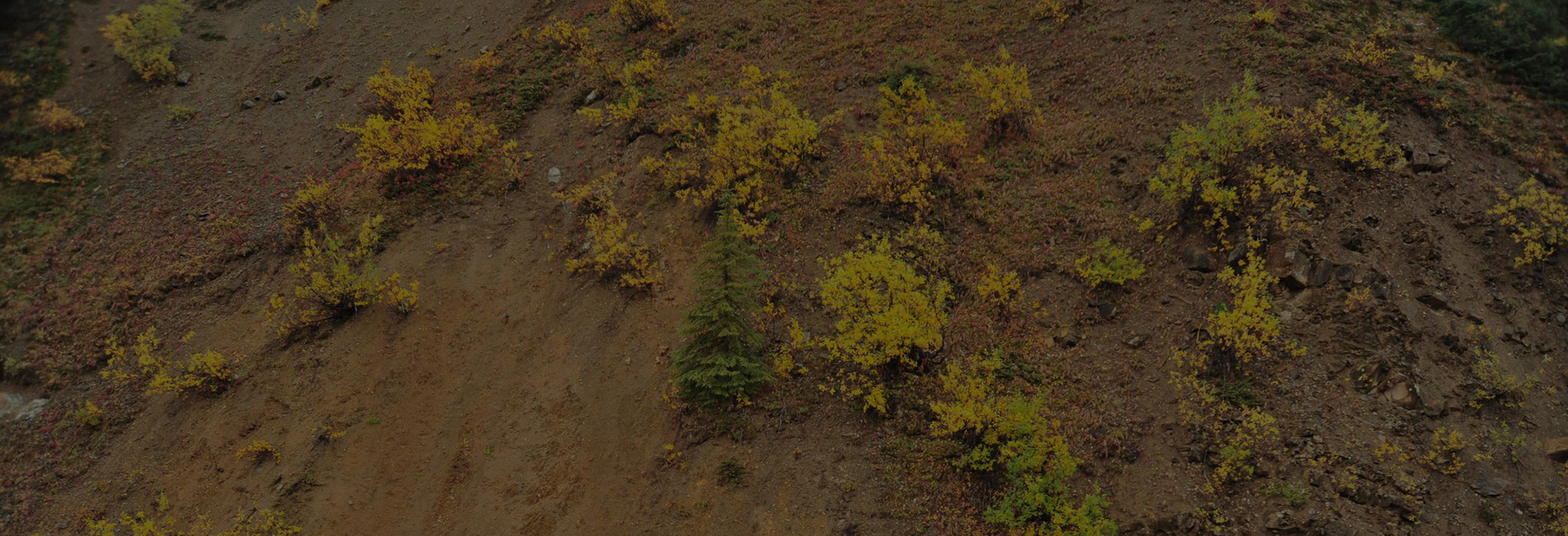- All 9 holes drilled on Einarson’s Jupiter Zone to date have intersected a near-surface pyrite and arsenopyrite-bearing structural zone over 230 m of strike length
- Mineralized interval widths range from 0.2 metres to 21.7 metres in drill core, true thicknesses currently unknown
- 1,560 metres of core have been drilled with assay results on select intervals pending
Vancouver, B.C., July 14, 2021 SNOWLINE GOLD CORP. (CSE: SGD) (US OTC: SNWGF) (the “Company” or “Snowline”) is pleased to announce that Phase I drilling at the Jupiter zone is nearing completion, having achieved its initial objective of discovering a mineralized structural zone thought to be partially responsible for gold-bearing quartz float boulders that grade up to 25.2 g/t Au previously found on the surface. Approximately 1,560 metres of drill core has been recovered from the Callisto target, with all 9 holes drilled to date intersecting a mineralized structure down to depths of 100 metres, and along a 230-metre-long structural trend. This trend, which follows a regional-scale feature, is open for further drill targeting in all directions. Full assay results from these mineralized intervals are expected by early to mid-August.
“The preliminary drilling results from Jupiter are encouraging” said Nikolas Matysek, CEO, and director of Snowline. “Discovering mineralized intervals in multiple holes across hundreds of metres is a sign of the significant potential at Jupiter. We are pleased that Snowline’s first drill programme has identified a potential source for the mineralized float found at surface and look forward to complete assay results.”

The ongoing Phase I diamond drill program initiated at the Jupiter zone tested a 3-kilometre long by up to 500-metre-wide area of anomalous gold-in-soil values accompanied by a prominent gold-bearing quartz boulder float train. All nine drill holes to have intersected a shallow north-easterly-dipping structural zone. (Figure 1). This zone comprises localized fault gauge and quartz, deformation and brecciation of sedimentary strata, and clay alteration of surrounding sedimentary units. The thickness of the mineralized zone in drill core, defined by the extent of arsenopyrite, ranges from 0.2 metres (Hole J-21-001; 50 m downhole) to 21.65 metres (Hole J-21-009; 18.5 m to 40.15 m downhole). True widths are currently unknown, though near 90-degree intersection angles with drill core suggest that true widths represent a substantial portion (75-100%) of widths intersected in drill core.
Mineralization consists of acicular arsenopyrite needles to much finer-grained arsenopyrite with a “sooty” appearance, along with pyrite (Figure 2). These sulphides occur as veins, patches and disseminations in quartz and in deformed sediments. Rare stibnite and trace realgar also occur in drill core. The zone generally occurs within a broader halo of clay alteration and disseminated pyrite. Structures and mineralized textures in core suggest that multiple fluid phases have affected mineralization.

B) Above interval in context of surrounding drill core. Note the preceding 25 cm interval to the left of the white quartz, comprising sulphide-rich quartz-carbonate vein material and fault gauge. This vein occurs at the base a broader 7.95 m zone of arsenopyrite mineralization in smaller quartz veins and disseminated in clay altered siltstones, within a broader halo of clay alteration and disseminated pyrite mineralization.
While encouraged by phase I drill results, which indicate the in-situ presence of an extensive epizonal orogenic gold system, the Company awaits assay results to better assess their significance.
Phase I drilling at Jupiter has been complemented by comprehensive surface work, including high-resolution drone surveying, local and regional geological mapping, infill soil sampling and trenching that will help to guide a second phase of drilling, if warranted by phase I results. Drilling has now moved to the Io target, some 650 metres southeast along strike of the same structural trend.

Rogue Project Advances
Soil sampling, structural mapping, prospecting and high-resolution drone surveying continue at the Rogue Project’s Valley Zone in preparation for Phase I drilling. Historical work during the 2010s at Valley discovered the presence of a reduced-intrusion related gold system, characterized by gold-bearing sheeted quartz veining within and around a newly discovered intrusion, and grab samples of sulphide vein material assaying from 0.5 g/t Au to 152 g/t Au within surrounding altered sediments.
Qualified Person
Information in this release has been reviewed and approved by Scott Berdahl, P. Geo., Chief Operating Officer of Snowline and a Qualified Person for the purposes of National Instrument 43-101. The Einarson and Rogue properties are both early-stage exploration prospects that do not presently contain any mineral resources as defined by National Instrument 43-101.
ABOUT SNOWLINE GOLD CORP.
Snowline Gold Corp. is a Yukon Territory focused gold exploration company with a 7-project portfolio covering over 90,000 ha. The Company is exploring its flagship 72,000 ha Einarson and Rogue gold projects in the prospective yet underexplored Selwyn Basin. Snowline’s projects all lie in the prolific Tintina Gold Province that hosts multiple million-ounce-plus gold mines and deposits, from Kinross’ Fort Knox mine to Newmont’s Coffee deposit. Snowline’s first mover claim position represents a unique opportunity to explore and expand a new greenfield, district-scale gold system.
ON BEHALF OF THE BOARD
Nikolas Matysek, B.Sc. (Geol)
CEO & Director
For further information, please contact:
Snowline Gold Corp.
+1-778-228-3020
info@snowlinegold.com
CAUTIONARY NOTE REGARDING FORWARD-LOOKING STATEMENTS
This news release contains certain forward-looking statements, including statements about the Company reviewing its newly acquired project portfolio to maximize value, reviewing options for its non-core assets, including targeted exploration and joint venture arrangements, conducting follow-up prospecting and mapping this summer and plans for exploring and expanding a new greenfield, district-scale gold system. Wherever possible, words such as “may”, “will”, “should”, “could”, “expect”, “plan”, “intend”, “anticipate”, “believe”, “estimate”, “predict” or “potential” or the negative or other variations of these words, or similar words or phrases, have been used to identify these forward-looking statements. These statements reflect management’s current beliefs and are based on information currently available to management as at the date hereof.
Forward-looking statements involve significant risk, uncertainties and assumptions. Many factors could cause actual results, performance or achievements to differ materially from the results discussed or implied in the forward-looking statements. Such factors include, among other things: risks related to uncertainties inherent in drill results and the estimation of mineral resources; and risks associated with executing the Company’s plans and intentions. These factors should be considered carefully and readers should not place undue reliance on the forward-looking statements. Although the forward-looking statements contained in this news release are based upon what management believes to be reasonable assumptions, the Company cannot assure readers that actual results will be consistent with these forward-looking statements. These forward-looking statements are made as of the date of this news release, and the Company assumes no obligation to update or revise them to reflect new events or circumstances, except as required by law.


